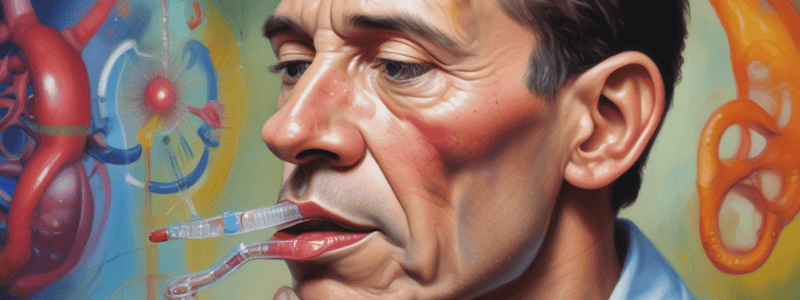Podcast
Questions and Answers
What is the term for difficulty breathing?
What is the term for difficulty breathing?
- Clubbing
- Apnea
- Orthopnea
- Dyspnea (correct)
Which condition is characterized by coughing up blood?
Which condition is characterized by coughing up blood?
- Hemoptysis (correct)
- Hypoxemia
- Rales
- Cyanosis
What does the term 'Clubbing' refer to in relation to respiratory diseases?
What does the term 'Clubbing' refer to in relation to respiratory diseases?
- Fluid in larger airways
- Bronchi spasms
- Fluid in smaller airways
- Poor distal circulation (correct)
Which term is used to describe 'musical whistling' sounds during breathing?
Which term is used to describe 'musical whistling' sounds during breathing?
What does 'Stridor' indicate in the context of respiratory diseases?
What does 'Stridor' indicate in the context of respiratory diseases?
What can cause 'Crackles' or 'Rales' in the lungs?
What can cause 'Crackles' or 'Rales' in the lungs?
'Hypoxemia' refers to the condition of:
'Hypoxemia' refers to the condition of:
What is a common viral infection in children that leads to airway narrowing, obstruction, and respiratory failure?
What is a common viral infection in children that leads to airway narrowing, obstruction, and respiratory failure?
Which disease is characterized by increased upper respiratory exudate and manifests as hoarseness, sore throat, and difficulty breathing?
Which disease is characterized by increased upper respiratory exudate and manifests as hoarseness, sore throat, and difficulty breathing?
Which condition involves inflammation of the larynx and presents with manifestations such as weak voice, sore throat, and dry cough?
Which condition involves inflammation of the larynx and presents with manifestations such as weak voice, sore throat, and dry cough?
Which respiratory condition is caused by overuse and can lead to manifestations like pain on palpation of the anterior neck and muffled voice?
Which respiratory condition is caused by overuse and can lead to manifestations like pain on palpation of the anterior neck and muffled voice?
What is the common name for the viral infection that causes airway swelling in children, leading to seal-like barking cough and dyspnea?
What is the common name for the viral infection that causes airway swelling in children, leading to seal-like barking cough and dyspnea?
Which condition involves increased production of mucus, trapping of air in the lungs, decreased oxygen exchange, dyspnea, and wheezing?
Which condition involves increased production of mucus, trapping of air in the lungs, decreased oxygen exchange, dyspnea, and wheezing?
Which condition is characterized by a barking cough in children?
Which condition is characterized by a barking cough in children?
What is the treatment of choice for croup?
What is the treatment of choice for croup?
Which of the following is a common manifestation of the common cold?
Which of the following is a common manifestation of the common cold?
What is the incubation period for the common cold?
What is the incubation period for the common cold?
Which condition is characterized by inflammation of the sinus cavities?
Which condition is characterized by inflammation of the sinus cavities?
What is a life-threatening condition that occludes the airway due to inflammation of the epiglottis?
What is a life-threatening condition that occludes the airway due to inflammation of the epiglottis?
Which of the following is a common manifestation of epiglottitis?
Which of the following is a common manifestation of epiglottitis?
Which of the following is the most common cause of bronchiolitis?
Which of the following is the most common cause of bronchiolitis?
Which of the following is NOT a typical manifestation of bronchiolitis?
Which of the following is NOT a typical manifestation of bronchiolitis?
Which type of pneumonia is confined to a single lobe of the lung?
Which type of pneumonia is confined to a single lobe of the lung?
Which of the following is the most frequent type of pneumonia?
Which of the following is the most frequent type of pneumonia?
Which of the following is routinely caused by viruses or uncommon bacteria?
Which of the following is routinely caused by viruses or uncommon bacteria?
Which of the following is acquired outside the hospital or healthcare setting?
Which of the following is acquired outside the hospital or healthcare setting?
Which of the following is a potential treatment for bronchiolitis?
Which of the following is a potential treatment for bronchiolitis?
Which of the following is a common cause of aspiration pneumonia?
Which of the following is a common cause of aspiration pneumonia?
Which of the following diagnostic tests is typically used for bronchiolitis?
Which of the following diagnostic tests is typically used for bronchiolitis?
What is the primary diagnostic tool used to confirm pneumonia?
What is the primary diagnostic tool used to confirm pneumonia?
Which symptom is most commonly associated with pneumonia in the elderly?
Which symptom is most commonly associated with pneumonia in the elderly?
What is the key characteristic of tuberculosis primary infection?
What is the key characteristic of tuberculosis primary infection?
Which preventive measure is specifically recommended for tuberculosis?
Which preventive measure is specifically recommended for tuberculosis?
What is the most appropriate initial treatment for tuberculosis?
What is the most appropriate initial treatment for tuberculosis?
Which type of hypersensitivity reaction is associated with the spread of tuberculosis to lymph nodes?
Which type of hypersensitivity reaction is associated with the spread of tuberculosis to lymph nodes?
What is the key principle emphasized in the text for managing the airway?
What is the key principle emphasized in the text for managing the airway?
What is the recommended first step in airway management?
What is the recommended first step in airway management?
What is the significance of the '3-3-2' rule mentioned in the text?
What is the significance of the '3-3-2' rule mentioned in the text?
What is the purpose of the Mallampati assessment mentioned in the text?
What is the purpose of the Mallampati assessment mentioned in the text?
Which of the following airway management techniques is considered the 'Best Way To Manage And Open The Airway' according to the text?
Which of the following airway management techniques is considered the 'Best Way To Manage And Open The Airway' according to the text?
What is the purpose of the 'Range Time' mentioned in the text?
What is the purpose of the 'Range Time' mentioned in the text?
What is the significance of the '4-90's' mentioned in the text?
What is the significance of the '4-90's' mentioned in the text?
What is the purpose of the 'Scissor Technique' mentioned in the text?
What is the purpose of the 'Scissor Technique' mentioned in the text?
What is the best way to manage BVM ventilations according to the text?
What is the best way to manage BVM ventilations according to the text?
What is the optimal position for intubating a non-traumatic adult patient?
What is the optimal position for intubating a non-traumatic adult patient?
What should be done when intubating an adult patient?
What should be done when intubating an adult patient?
What is the best way to manage an airway using a bag valve mask?
What is the best way to manage an airway using a bag valve mask?
What is the optimal position for intubating a child or pediatric patient?
What is the optimal position for intubating a child or pediatric patient?
What should be done when intubating an adult patient to ensure proper blade and body position?
What should be done when intubating an adult patient to ensure proper blade and body position?
What is the best way to manage BVM ventilations according to the traditional method?
What is the best way to manage BVM ventilations according to the traditional method?
Study Notes
Respiratory Diseases
- Dyspnea refers to difficulty breathing.
- Hemoptysis is characterized by coughing up blood.
- Clubbing refers to a deformity of the fingers and toes, often associated with respiratory diseases.
- Wheezing is described as a 'musical whistling' sound during breathing.
- Stridor indicates a high-pitched sound during breathing, often associated with upper airway obstruction.
- Crackles or Rales in the lungs can be caused by fluid accumulation, pneumonia, or bronchiectasis.
- Hypoxemia refers to a condition of low oxygen levels in the blood.
Childhood Respiratory Infections
- Croup is a common viral infection in children that leads to airway narrowing, obstruction, and respiratory failure.
- Laryngitis is characterized by increased upper respiratory exudate, hoarseness, sore throat, and difficulty breathing.
- Epiglottitis is a life-threatening condition that occludes the airway due to inflammation of the epiglottitis, often presenting with a high fever, difficulty breathing, and drooling.
- The common cold is characterized by a runny nose, sore throat, and cough, with an incubation period of 2-3 days.
Pulmonary Conditions
- Bronchiolitis is a respiratory condition characterized by increased production of mucus, trapping of air in the lungs, decreased oxygen exchange, dyspnea, and wheezing, often caused by viruses.
- Lobar pneumonia is confined to a single lobe of the lung.
- Community-acquired pneumonia is the most frequent type of pneumonia, acquired outside the hospital or healthcare setting.
- Aspiration pneumonia is often caused by inhaling food, liquids, or other substances into the lungs.
Tuberculosis
- Tuberculosis primary infection is characterized by a localized infection with limited spread.
- The Bacille Calmette-Guérin (BCG) vaccine is a preventive measure specifically recommended for tuberculosis.
- The most appropriate initial treatment for tuberculosis is a combination of antibiotics.
Airway Management
- The key principle emphasized in airway management is maintaining a patent airway.
- The recommended first step in airway management is to assess the patient's airway.
- The '3-3-2' rule states that the airway should be assessed within 3 minutes, 3 attempts at intubation, and 2 minutes for each attempt.
- The Mallampati assessment is used to evaluate the patient's airway.
- The 'Best Way To Manage And Open The Airway' is the Head-Elevated Laryngoscopy (HEL) technique.
- The 'Range Time' refers to the time it takes to prepare for intubation.
- The '4-90's' rule states that the patient should be pre-oxygenated for 4 minutes, and the intubation attempt should be made within 90 seconds.
- The 'Scissor Technique' is used to open the airway.
- The best way to manage BVM ventilations is to use a two-person technique.
- The optimal position for intubating a non-traumatic adult patient is the sniffing position.
- When intubating an adult patient, the blade and body position should be ensured to be proper.
- The optimal position for intubating a child or pediatric patient is the neutral position.
- When intubating a child or pediatric patient, the head should be in a neutral position, and the blade should be inserted at the midpoint of the tongue.
Studying That Suits You
Use AI to generate personalized quizzes and flashcards to suit your learning preferences.
Description
Test your knowledge on the signs and symptoms of respiratory diseases with this quiz based on the lecture by Steve Casarez, RN, NRP. Identify key indicators such as dyspnea, hypoxemia, cyanosis, sputum, clubbing, rales or crackles, and more.





